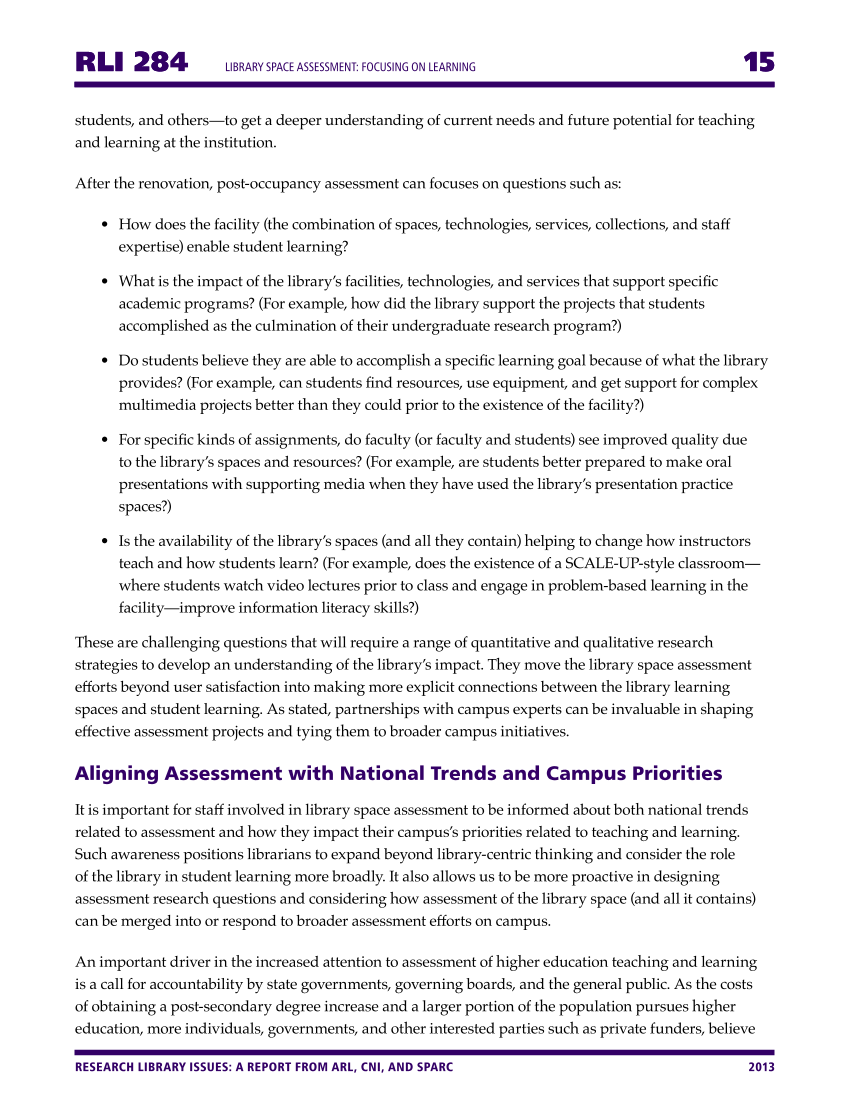RLI 284 Library Space Assessment: Focusing on Learning 15 RESEARCH LIBRARY ISSUES: A REPORT FROM ARL, CNI, AND SPARC 2013 28 students, and others—to get a deeper understanding of current needs and future potential for teaching and learning at the institution. After the renovation, post-occupancy assessment can focuses on questions such as: • How does the facility (the combination of spaces, technologies, services, collections, and staff expertise) enable student learning? • What is the impact of the library’s facilities, technologies, and services that support specific academic programs? (For example, how did the library support the projects that students accomplished as the culmination of their undergraduate research program?) • Do students believe they are able to accomplish a specific learning goal because of what the library provides? (For example, can students find resources, use equipment, and get support for complex multimedia projects better than they could prior to the existence of the facility?) • For specific kinds of assignments, do faculty (or faculty and students) see improved quality due to the library’s spaces and resources? (For example, are students better prepared to make oral presentations with supporting media when they have used the library’s presentation practice spaces?) • Is the availability of the library’s spaces (and all they contain) helping to change how instructors teach and how students learn? (For example, does the existence of a SCALE-UP-style classroom— where students watch video lectures prior to class and engage in problem-based learning in the facility—improve information literacy skills?) These are challenging questions that will require a range of quantitative and qualitative research strategies to develop an understanding of the library’s impact. They move the library space assessment efforts beyond user satisfaction into making more explicit connections between the library learning spaces and student learning. As stated, partnerships with campus experts can be invaluable in shaping effective assessment projects and tying them to broader campus initiatives. Aligning Assessment with National Trends and Campus Priorities It is important for staff involved in library space assessment to be informed about both national trends related to assessment and how they impact their campus’s priorities related to teaching and learning. Such awareness positions librarians to expand beyond library-centric thinking and consider the role of the library in student learning more broadly. It also allows us to be more proactive in designing assessment research questions and considering how assessment of the library space (and all it contains) can be merged into or respond to broader assessment efforts on campus. An important driver in the increased attention to assessment of higher education teaching and learning is a call for accountability by state governments, governing boards, and the general public. As the costs of obtaining a post-secondary degree increase and a larger portion of the population pursues higher education, more individuals, governments, and other interested parties such as private funders, believe






















